Introduction
Qatar, a small but affluent nation in the Middle East, has witnessed rapid economic growth over the past few decades. Once a modest pearl-diving and fishing economy, Qatar has transformed into one of the wealthiest countries in the world, thanks to its abundant natural gas reserves. This article delves into Qatar’s economic evolution, key growth drivers, diversification efforts, and future prospects.
Historical Economic Background
Before the discovery of oil and gas, Qatar’s economy was primarily based on fishing and pearl diving. The economic landscape changed dramatically in the mid-20th century when oil and gas resources were discovered. These resources laid the foundation for modern economic prosperity, allowing Qatar to develop infrastructure, social services, and a high standard of living for its citizens.
Key Drivers of Qatar’s Economic Growth
1. Natural Gas and Oil Industry
Qatar is one of the largest producers of liquefied natural gas (LNG) in the world. The development of the North Field, the world’s largest natural gas reservoir, has positioned Qatar as a global energy powerhouse. The country’s wealth and rapid GDP growth are largely attributed to the revenues generated from the oil and gas sector.
2. Government Investments and Economic Policies
The Qatari government has played a crucial role in shaping economic growth through strategic investments and policies. The Qatar National Vision 2030 (QNV 2030) aims to diversify the economy, reduce dependency on hydrocarbons, and enhance human capital development. This vision is supported by strong fiscal policies and sovereign wealth management strategies.
3. Foreign Direct Investment (FDI) and Trade
Qatar has actively encouraged foreign investment by creating a business-friendly environment. Initiatives such as free zones, tax incentives, and relaxed foreign ownership laws have attracted multinational corporations and boosted economic expansion.
4. Infrastructure Development
Massive infrastructure projects, including stadiums, metro systems, highways, and smart cities, have been key contributors to Qatar’s economic growth. The successful hosting of the FIFA World Cup 2022 further accelerated infrastructure investments and global exposure.
5. Tourism and Hospitality
The tourism sector has been growing rapidly, with Qatar investing in luxury hotels, cultural attractions, and business tourism. The government has launched several initiatives, such as visa-free entry for many nationalities, to attract international visitors.
Economic Diversification Efforts
Recognizing the risks of over-reliance on hydrocarbons, Qatar has implemented various initiatives to diversify its economy.
1. Non-Oil Sectors Development
Industries such as finance, manufacturing, logistics, and technology have been promoted as part of Qatar’s economic diversification strategy. Qatar Financial Centre (QFC) and Qatar Science & Technology Park (QSTP) are some of the key initiatives supporting this shift.
2. Agriculture and Food Security
Qatar has made significant strides in achieving food security through investments in local agriculture and sustainable farming techniques. The blockade imposed by neighboring countries in 2017 accelerated efforts to become more self-sufficient.
3. Education and Knowledge-Based Economy
Investments in education and research institutions such as Qatar Foundation, Hamad Bin Khalifa University, and partnerships with global universities aim to create a knowledge-based economy. This fosters innovation and human capital development.
Challenges to Economic Growth
1. Dependence on Hydrocarbons
Despite diversification efforts, Qatar’s economy remains heavily reliant on oil and gas revenues, making it vulnerable to fluctuations in global energy prices.
2. Regional Geopolitical Tensions
Qatar’s economic growth has been influenced by regional dynamics, including past diplomatic disputes and trade blockades. While the economy has proven resilient, geopolitical risks remain a challenge.
3. Climate and Environmental Concerns
As a nation with extreme climate conditions, Qatar faces environmental challenges such as water scarcity, rising temperatures, and the need for sustainable development. Addressing these concerns is crucial for long-term growth.
Future Economic Outlook
Qatar’s economic future appears promising, with continued investments in diversification, innovation, and sustainability. Key focus areas include expanding digital transformation, green energy initiatives, and global trade partnerships. With strong leadership and strategic planning, Qatar is well-positioned to maintain its economic growth and resilience in an evolving global landscape.
Conclusion
Qatar’s remarkable economic growth story showcases its transformation from a resource-dependent economy to a globally recognized financial and trade hub. By focusing on diversification, innovation, and sustainable development, Qatar is shaping a future that ensures long-term prosperity and economic stability.
Do follow on Instagram
Also Read: Qatar’s Vision 2030: How Automations and Technology are Transforming the Nation



